Morio Worm Care Sheet written by Paul Flexman for TheAmphibian.co.uk
Common name: Morio worms
Scientific Name:Zoophobus morio
Description
Description: A commonly used feeder insect for larger insectivorous reptiles, amphibians and birds. The morio worm is not, as suggested by its name, a worm but the larval stage of a species of a darkling beetle.
Size: Up to 40mm
Life span: Dependant on the captive environment chosen.
Origin: Uncertain but thought to be Central America.
Temperament: Adults are docile and will quite happily explore your hand. The larval stages can be quite feisty and will try and bite but inflict little if any damage.
The benefits of Morio worms as a food item.
Morio Worms are high in protein and fat so are good for a host of reptiles and amphibians that need building up. This is also a reason why Morio Worms should not be regarded as a stable, as reptiles and amphibians can become overweight if this is the only food item available, so should always be offered as part of a varied and well-balanced diet.
A wide range of lizards and amphibians will take Morio Worms readily, even when they are reluctant to take other prey items, although some delicate species should not be fed Morio Worms due to their hard exoskeleton which can be difficult to digest.
Both the larva and the beetles are edible.
They are also very easy to keep, cheap to house and feed, fast to breed and odourless, so make a great live food to have readily available within the home.
General Care
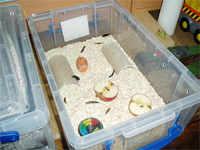 Figure 1: The Colony |
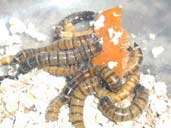 Figure 2: Morio Worms Feeding |
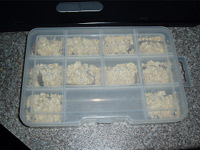 Figure 3: Isolation |
Housing: A 9l Really Useful Box (RUB) with holes drilled in the lid and high up on the sides is ideal for keeping an average size colony content (13 adults in my own colony). If a larger colony is to be kept then increase the size of the RUB proportionately.
Substrates: My own personal preference is porridge oats but bran could also be used.
Humidity: Normal room humidity (based on UK humidity) is fine as long as they have some fresh veg or fruit in the RUB to provide the insects with a source of water.
Temperatures: My own colony is kept at around 20–24°C (70–78°F) and is thriving. A temperature drop naturally occurs at night as the colony does not have its own independent heat source.
Lighting: Normal room lighting is adequate as long as the lights go out at night to provide a regular photoperiod. It’s not the end of the world if you forget to switch the light off though. They are pretty adaptable little critters.
Feeding: The adults and larvae consume the porridge oats/bran that make up the substrate. Fresh veg and fruit will also be avidly consumed. Carrots and parsnips seem to be appreciated the most.
Sexing: Good luck with this one unless you have a dissection microscope and lots of patience.
Breeding: So here’s where the fun and games start. In order for you to breed morio worms you need adult beetles. Whilst the larvae are housed together as a group they will not pupate so in order to make this happen they must be isolated from each other as shown in figure 3 in an old component tray. Remember to pierce a hole in the lid with a pin above each compartment. The hole can not be any larger otherwise the larvae will be able to chew their way to freedom.
After a couple of weeks or so, if all goes well, the larvae will have transformed into pupae and after another couple of weeks the pupae will transform into adult beetles. The newly emerged beetles will be a rusty, chestnut brown but will gradually darken as they develop into mature adults. Once they reach this stage they will, if the conditions are suitable, begin courtship and mating. By keeping the RUB well ventilated and providing plenty of fresh fruit and vegetables you should be able to ensure that the beetles will be happy little campers. The first signs that mating may be about to start is that the beetles will start to follow each other around rather than avoiding each other and they will begin to touch antennae.
If all goes to plan then a few weeks after this:
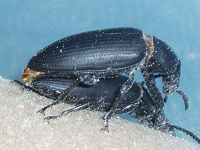
You should end up with lots of these:
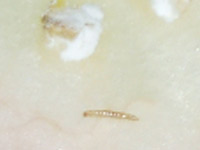
Other Useful Information about Morio Worms
Some reptile shops may feed their morio worms with a hormone to stop metamorphosis and plus prolonging the morio worm’s shelf life as a live food. If you are starting a colony you will need to ensure that your morio worms can complete their life cycle, so it’s advisable to purchase your starter colony from a hormone free source.
The main problem that may arise in a morio worm colony is infestation by mites and other parasites. This can be avoided by keeping your morio worm container and contents dry. If your colony does become infested, it is advisable to throw the colony away and start another with a new starter of morio worms and a fully sterilised or new container.
Any other questions about Morio Worms?
This care sheet is a simple step-by-step guide about the breeding and keeping of Morio worms, but if it has not answered all of your questions about breeding Morio Worms as a live food then please enter theAmphibian.co.uk forum. We have a 'Culturing Live Food' section where our experienced members would be happy to answer any queries you may have about Morio Worms and their care.

